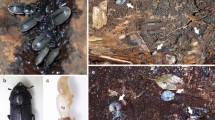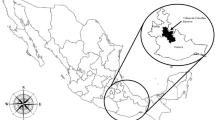Abstract
The feeding behavior ofDrosophila serido on the yeast communities of necrotic stem tissue ofPilosocereus arrabidae were studied in a sand dune ecosystem of Rio de Janeiro, Brazil. The prevalence of cactophilic yeasts includingPichia barkeri, Candida sonorensis andGeotrichum sp. in the crops and external surfaces ofD. serido reflected its association with the cactus habitat. The effective number of yeasts vectored on the surface of flies was higher than that in the crops. Also overlap between the yeasts from stems and from crops was partial suggesting selective feeding by the flies in the substrates visited. The females had a higher effective number of yeast species and a lower similarity than males with the yeast community ofP. arrabidae. This was probably related to the search for oviposition sites by females. The presence ofPichia thermotolerans-like andPichia amethionina varpachycereana in the flies, but not inP. arrabidae stems, indicated thatD. serido was not limited to this cactus species. The larvae and adults lived in different patches with the adults feeding in patches with higher yeast species richness. The larvae had a narrower feeding niche and higher overlap withP. arrabidae, and preferredP. barkeri andPichia cactophila as food. Adult flies fed on patches with the most frequent yeasts except forP. cactophila. Pichia caribaea was found in higher frequency in the adult crops than in the stems. Our data suggested that there was food selection and diet partitioning between adult and larval stages ofD. serido.
Similar content being viewed by others
References
Barnett JA, Payne RW, Yarrow D (1990) Yeasts, Characteristics and Identification. Cambridge University Press, Cambridge
Brown JS (1982) Coexistence on a seasonal resource. Am. Naturalist 133(2): 168–181
Fogleman JC (1982) The role of volatiles in the ecology of cactophilicDrosophila. In: Barker JSF & Starmer WT (Eds) Ecological Genetics and Evolution: The Cactus-Yeast-Drosophila Model System (pp 191–206). Academic Press, Sydney
Fogleman JC, Starmer WT, Heed WB (1981) Larval selectivity for yeast species byDrosophila mojavensis in natural substrates. Proc. Natl. Acad. Sci. USA 78: 4435–4439
Fogleman JC, Starmer WT, Heed WB (1982) Comparisons of yeast flora from natural substrates and larval guts of South WesternDrosophila. Oecologia 52: 187–198
Foster JLM & Fogleman JC (1993) Identification and ecology of bacterial communities associated with necrosis of three cactus species. Appl. Environ. Microbiol. 59: 1–6
Ganter PF (1988) The vectoring of cactophilic yeasts byDrosophila. Oecologia 75: 400–404
Hagler AN & Mendonça-Hagler LC (1991) A Diazonium Blue B test for yeasts grown three days on Yeast Carbon Base-Urea Agar. Rev. Microbiol. 22: 71–74
Heed WB, Starmer WT, Miranda M, Miller MW & Phaff HJ (1976) An analysis of the yeast flora associated with cactophilicDrosophila and their host plants in the Sonoran Desert and its relations to the temperate and tropical associations. Ecology 57: 151–160
Hulbert SH (1978) The measurement of niche overlap and some relatives. Ecology 59: 67–77
Kreger-Van Rij NJW (1984) The Yeasts, A Taxonomic Study. Third edition, Elsevier Science Publ., Amsterdam
Lachance MA & Starmer WT (1982) Evolutionary significance of physiological relationships among yeast communities associated with trees. Can. J. Bot. 60: 285–293
Lachance MA, Starmer WT & Phaff HJ (1988) Identification of yeasts found in decaying cactus tissues. Can. J. Microbiol. 34: 1025–1036
Morisita M. (1971) Composition of the Ig-Index. Res. Pop. Ecol. 13: 1–27
Rosa CA, Hagler AN, Mendonça-Hagler LC, Morais PB, Gomes NCM & Monteiro RF (1992)Clavispora opuntiae and other yeasts associated with the mothSigelgaita sp. in the cactusPilosocereus arrabidae of Rio de Janeiro. Antonie van Leeuwenhoek 62: 267–272
Rosa CA, Morais PB, Hagler AN, Mendonça-Hagler LC & Monteiro RF (1994) Yeast communities of the cactusPilosocereus arrabidae and associated insects in Sandy Coastal Plains in Southeastern Brazil. Antonie van Leeuwenhoek, 65: 55–62
Ruiz A, Fontdevila A & Wasserman M (1982) The evolutionary history ofD. buzzatii III. Cytogenetic relationships between to sibling species of thebuzzatii cluster. Genetics 101: 503–518
Sang JH (1978) The nutritional requirements ofDrosophila. In: Ashburner M & Wright TRF (Eds) The Genetics and Biology ofDrosophila, Vol 2 (pp 159–192). Academic Press, London
Sene FM, Pereira MAQR & Vilela CR (1982) Evolutionary aspects of the cactus breeding Drosophila species in South America. In: Barker JSF & Starmer WT (Eds) Ecological Genetics and Evolution: The Cactus-Yeast-Drosophila Model System (pp 97–106). Academic Press, Sydney
Sene FM, Pereira MAQR & Vilela CR (1988) Constrasting patterns of differentiation inferred from traditional genetic markers and the process of speciation. Pacific Sci. 42: 81–88
Starmer WT & Fogleman JC (1986) Coadaptation ofDrosophila and yeasts in their natural habitats. J. Chem. Ecol. 12: 1037–1055
Vilela CR, Pereira MAQR & Sene FM (1982) Preliminary data of the geographical distribution ofDrosophila species within morphoclimatic domains in Brazil II. The repleta group. Ciencia e Cultura 35: 66–70
Van der Walt JP & Yarrow D (1984) Methods for isolation, maintenance, classification and identification of yeasts. In: Kreger-van Rij NJW (Ed) The yeasts, A Taxonomic Study (pp 45–103). Elsevier Science Publ., Amsterdam
Author information
Authors and Affiliations
Rights and permissions
About this article
Cite this article
Morais, P.B., Rosa, C.A., Hagler, A.N. et al. Yeast communities of the cactusPilosocereus arrabidae as resources for larval and adult stages ofDrosophila serido . Antonie van Leeuwenhoek 66, 313–317 (1994). https://doi.org/10.1007/BF00882766
Received:
Accepted:
Issue Date:
DOI: https://doi.org/10.1007/BF00882766




